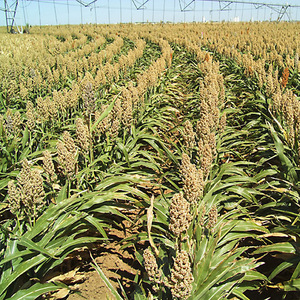Researchers: Genetically improving sorghum could benefit biofuels

USDA Agricultural Research Service
July 14, 2016
BY Genetics Society of America
The bioenergy crop sorghum holds great promise as a raw material for making environmentally friendly fuels and chemicals that offer alternatives to petroleum-based products. Sorghum can potentially yield more energy per area of land than other crops while requiring much less input in terms of fertilizer or chemicals. New research examines how genetic improvement of specific sorghum traits, with an eye toward sustainability, could help maximize the usefulness of sorghum as a bioenergy crop.
The work was conducted by researchers from the University of Florida in Gainesville, Washington State University in Pullman, the USDA-ARS in Lincoln, Nebraska, and the University of Missouri, Columbia. They highlight disease resistance, flooding tolerance and cell wall composition as key targets for genetically improving sorghum for sustainable production of renewable fuels and chemicals.
Improving disease resistance, especially to the fungal disease anthracnose, would help expand sorghum to low-productivity land in the southeastern United States. By making the crop more flood resistant, it could be grown on land prone to seasonal flooding that is not typically used for food crops. Finally, making changes in sorghum's cell wall composition could greatly increase the yield of fermentable sugars that can then be converted to fuels such as ethanol. The researchers are using multidisciplinary approaches to make genetic modifications linked with all three traits, with the aim of improving sorghum for renewable energy and chemical production.
Wilfred Vermerris will present this research from 9:00-9:15 p.m. during the PEQG Keynote 2 in Crystal Ballroom J1, K-L as part of The Allied Genetics Conference, Orlando World Center Marriott, Orlando, Florida.
Advertisement
Advertisement
Advertisement
Advertisement
Related Stories
The U.S Department of Energy Bioenergy Technologies Office, in partnership with the Algae Foundation and NREL, on July 21 announced the grand champion and top four winning teams of the 2023 - 2025 U.S. DOE AlgaePrize Competition.
The USDA significantly increased its estimate for 2025-’26 soybean oil use in biofuel production in its latest World Agricultural Supply and Demand Estimates report, released July 11. The outlook for soybean production was revised down.
U.S. fuel ethanol capacity fell slightly in April, while biodiesel and renewable diesel capacity held steady, according to data released by the U.S. EIA on June 30. Feedstock consumption was down when compared to the previous month.
The U.S. EPA on July 8 hosted virtual public hearing to gather input on the agency’s recently released proposed rule to set 2026 and 2027 RFS RVOs. Members of the biofuel industry were among those to offer testimony during the event.
The USDA’s Risk Management Agency is implementing multiple changes to the Camelina pilot insurance program for the 2026 and succeeding crop years. The changes will expand coverage options and provide greater flexibility for producers.
Upcoming Events










